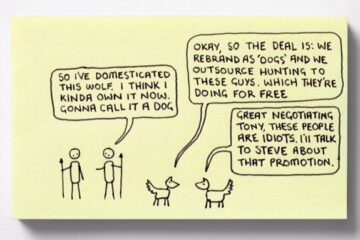Am I being too harsh?
The truth is, I find Rand Fishkin quite likable. I’ve seen him give a few talks at Turning Fest – and I enjoyed every talk.
And, as far as I can tell, he knows a lot about SEO. (How can I tell?)
But, when it comes to paid marketing, he does tend to write some pretty silly stuff.
I’ve written in the past about his “organic gets 16x as many clicks as paid” comments. (That’s true, but it’s the correct answer to the wrong question.)
And now he’s back with his “analysis” of whether or not paid advertising works.
In What if Performance Advertising is Just an Analytics Scam? he leads off with this quote from the CEO of AirBnB:
“What the pandemic showed is we can take marketing down to zero and still have 95% of the same traffic as the year before. So we’re not going to forget that lesson.”
And then argues that paid online marketing often does little other than cannibalise conversions from other channels.
i.e. It’s not creating conversions, it’s merely stepping in front of prospects who would have converted anyway…and then claiming credit for those conversions.
So let’s look at the evidence…
“AirBnB cut $542 million of performance advertising spend and saw no measurable falloff in attributable sales”
To make the case that ads don’t help, I’m not sure I’d pick a fast-growing holiday rentals company that tanked during lockdown.
But let’s look at the details (which Fishkin didn’t give).
According to Airbnb CEO, Brian Chesky :
“And then 2020 occurred, our business drops by 80% in eight weeks, and we pulled back all marketing, including performance marketing.
“But something remarkable happened. Even before we started resuming our marketing spend, our traffic levels came back to 95% of the traffic levels of 2019 without any marketing spend.
“And what this revealed is that our brand is inherently strong. It’s a noun and a verb in pop culture.”
So, contrary to Rand’s claim, they didn’t cut performance marketing and THEN see no drop off in attributable sales. If they did, that would demonstrate a clear cause-and-effect.
But that didn’t happen.
They cut their marketing when sales were tanking. Then, later, their business bounced back when lockdowns were relaxed.
And traffic bounced back to 95% of the previous level. So that must mean the ads were only increasing traffic by 5%, right?
Well…not really.
Remember, Airbnb was a growing company. It had grown 32% between 2018 and 2019.
If we assume similar growth would have happened between 2019 and 2020 – if it hadn’t been for covid19 – then they’ve bounced back to getting 95 out of every 132.
That’s only 72%, not 95%.
And that 28% drop is a lot different to the 5% drop we’re being encouraged to see.
The truth is we don’t know if bouncing back to 95% is good or bad.
With continuing travel restrictions – and so many people still reluctant to travel – you’d expect a reduction in traffic year-on-year.
On the other hand, you could assume some amount of pent-up demand for travel that would turn into traffic in late 2020 when travel restrictions were eased.
Not only that but in a pandemic, AirBnBs might be seen as a safer option than hotels.
So we have a combination of headwinds (travel restrictions and the unwillingness to travel) and tailwinds (fast growing, pent-up-demand).
Why would we expect all those factors to net out at zero?
So…to sum up…we’re looking at a fast-growing household-name business that’s operating in unprecedented times. Therefore, making a before-and-after comparison doesn’t tell us much.
What about Rand’s other examples?
Obviously, Rand isn’t going to base his argument on just one company’s experience.
He said he was “equally interested in the stories of small and medium-sized advertisers who’ve been shocked to discover their search ads, retargeting, programmatic display ads, LinkedIn ads, Reddit ads, Facebook ads, etc. are some combination of entirely ineffective, fraudulent, and/or incrementally non-additive.”
I didn’t wade through all of these. I stuck to search ads and Facebook ads. Those are the two traffic sources I know well.
The search ad story was a company who, by their admission, screwed up its landing page strategy and had Quality Score issues.
When they fixed these, their results improved.
Hardly a damning indictment of Google Ads.
The Facebook story was some nonsense where the writer cherry-picked what looked to be some poorly targeted ads. He didn’t even claim the campaigns weren’t profitable – just that ads were shown to existing customers.
(Either accidentally or deliberately.)
Neither of these articles adds weight to Rand’s suggestion that “Performance Advertising is Just an Analytics Scam.”
More bad examples…
Rand lists more companies.
Let’s go through a few of them…
“When P&G turned off $200 million of their digital ad spending, they saw NO CHANGE in business outcomes”
Sounds like a lot, doesn’t it?
But it’s less than 10% of their digital spend. It’s hardly surprising that, if a company does a proper audit of its ad spend, it can find a way to spend 10% less and still get the same revenue – especially if they’re doing a lot of display advertising.
“When Chase reduced their programmatic reach from 400,000 sites showing its ads to 5,000 sites (a 99% decrease), they saw NO CHANGE in business outcomes”
It’s a 99% decrease in the number of sites their ads are showing on. You might think that means a huge cut in spend, but it might be less than 5% of their actual ad impressions.
Then there’s Uber.
“When Uber turned off $120 million of their digital ad spending meant to drive more app installs, they saw NO CHANGE in the rate of app installs”
That’s the same Uber that’s suing its ad agencies for fraud. I blogged about this in early 2021 .
Yes, being (allegedly) defrauded by your ad agency will definitely be a drag on your performance. But I’d suggest that’s more a reflection of their willingness to defraud you – and your lack of diligence – than a reflection of the quality of paid advertising.
So, again, three bad examples – each presented in a way that one might think of as “misleading.”
What if 60-99% of people seeing ads would have bought anyway?
And, based on these bad examples. Rand writes:
“Herein lies the scam. I’m not saying ‘ no one buys because of a retargeting/display/branded search ad. ’ I’m saying, ‘ somewhere between 60-99%* of the people exposed to those ads would have purchased anyway. ’”
60-99% is quite a range, isn’t it?
It’s saying that, “OK, some of these people wouldn’t have bought if they hadn’t seen those ads. And that number might be 1%. Or it might be 40%.”
And to call that a “scam” is quite a leap.
Yes, when you bid on your brand name on Google, you’re going to get people clicking on your ads who would have otherwise clicked on your organic listing.
And, even by Rand’s admission, up to 40% of the people who clicked on those ads WOULDN’T have clicked on your organic listing.
(Or, to be more accurate, he’s saying up to 40% of the BUYERS wouldn’t have clicked on the organic.)
So is this a problem?
Given brand clicks tend to be much cheaper than non-brand clicks, and given those clicks will usually convert at a far higher rate, it’s quite possible for the cost/conversion of brand campaigns to be less than 70%+ lower than for your non-brand campaigns.
Which would mean that, even if 60% of those conversions would have happened anyway, you’re still getting a better ROAS from brand than non-brand.
But, while brand bidding might be a good idea if 40% of brand conversions are “added” conversions, what happens if it’s just 1%?
How to test this and get the real number
Fortunately, rather than using wide-ranging estimates based on the experience of a few companies, there’s a simple test you can run: switch off your brand bidding in certain locations, while letting it run in others.
Then look at your analytics.
Compare the dropoff in total conversions (all traffic) in the areas where you stopped brand advertising, compared to the areas where you continued to advertise on your brand.
How big was it?
Then take the money you saved by not running those ads, divide it by the number of lost conversions and you have an estimate of what brand conversions are really costing you.
It’s not going to be precise, but it’s a lot more precise than “somewhere between 1% and 40%.”
“So is performance marketing NOT a scam?
No, it’s not a scam, unless it’s possible to scam yourself.
As I wrote in my blog post about Uber suing its ad agencies ,
If you’re spending millions of dollars on ads and you’re not auditing the performance of the ads – or getting a 3rd party audit – you should put on a clown suit.
Listen, it’s YOUR job to track your ROAS.
Yes, you should listen to your PPC people.
You should listen to them, but THEN you should double-check what they’re saying – especially if they’re on a performance incentive. (But, even if they aren’t.)
And, if you don’t have someone on your team who can do that sort of work, then hire someone like me as a consultant.
Either way, put on your big boy trousers and, rather than blaming “scams,” take responsibility for your marketing strategy.
Steve Gibson



